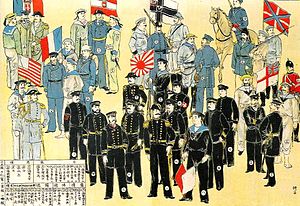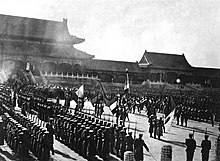
Back حلف الأمم الثمانية Arabic Səkkiz Gücün Alyansı Azerbaijani Альянс васьмі дзяржаў Byelorussian Алианс на осемте държави Bulgarian Aliança de les Vuit Nacions Catalan Vereinigte acht Staaten German Οκταεθνής Συμμαχία Greek Alianco de la ok nacioj Esperanto Alianza de las Ocho Naciones Spanish Alliance des huit nations French
| Eight-Nation Alliance | |
|---|---|
| 八國聯軍 (in Chinese) | |
 The eight nations with their naval ensigns, from top to bottom, left to right: | |
| Active | 10 June 1900 – 7 September 1901 (1 year, 90 days) |
| Country | |
| Allegiance | None (individual) |
| Type | Expeditionary force |
| Role | To relieve a siege of various legations, suppress the Boxer Rebellion, and safeguard privileges of foreign nationals and Chinese Christians. |
| Size | About 51,755 troops |
| Nickname(s) | Coalition |
| Engagements | Boxer Rebellion |
| Commanders | |
| Notable commanders | Second: First: |
| Eight Nation Alliance | |||||||||
|---|---|---|---|---|---|---|---|---|---|
 The Eight-Nation Alliance in Beijing following the defeat of the Boxer Rebellion in 1901; identifiable flags in picture: | |||||||||
| Traditional Chinese | 八國聯軍 | ||||||||
| Simplified Chinese | 八国联军 | ||||||||
| |||||||||
The Eight-Nation Alliance was a multinational military coalition that invaded northern China in 1900 during the Boxer Rebellion, with the stated aim of relieving the foreign legations in Beijing, which was being besieged by the popular Boxer militiamen, who were determined to remove foreign imperialism in China. The allied forces consisted of about 45,000 troops from the eight nations of Germany, Japan, Russia, Britain, France, the United States, Italy, and Austria-Hungary. Neither the Chinese nor the quasi-concerted foreign allies issued a formal declaration of war.[1]
No treaty or formal agreement bound the alliance together. Some Western historians define the first phase of hostilities, starting in August 1900, as "more or less a civil war",[1] though the Battle of the Taku Forts in June pushed the Qing government to support the Boxers. With the success of the invasion, the later stages developed into a punitive colonial expedition, which pillaged Beijing and North China for more than a year. The fighting ended in 1901 with the signing of the Boxer Protocol.[2]
- ^ a b Klein (2008), p. 3.
- ^ Hevia, James L. "Looting and its discontents: Moral discourse and the plunder of Beijing, 1900–1901" in R. Bickers and R.G. Tiedemann (eds.), The Boxers, China, and the world Lanham, Maryland: Rowman & Littlefield Publishers, 2009 ISBN 9780742553958